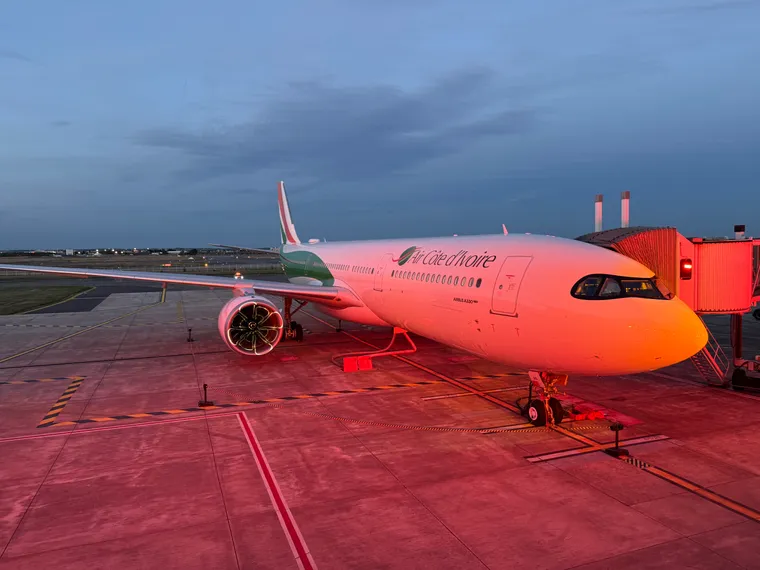Air Côte d’Ivoire’s new Airbus A330neo aircraft, with its four-class configuration — first, business, premium economy, and economy — isn’t just notable for how the airline hopes to use it to transform the dynamics of airline travel in West Africa, develop new banks for connections over its Abidjan hub, and how it plans to take on the competition to Paris in the shape of Air France and Corsair.
The aircraft is also an informative snapshot of the current state of the cabin interiors, seating and airline industry: what’s possible in terms of creating new product with today’s existing product offerings, what seatmakers are willing and/or able to offer to smaller airlines, and the certification issues that continue to delay aircraft delivery, leaving airlines with little choice but to operate their newest planes with seats blocked off.
The Up Front toured the aircraft at its launch in Toulouse, and quizzed senior Air Côte d’Ivoire management at the Airbus Delivery Centre during a gala event (full disclosure: Airbus provided return flights from Brussels and a night in Toulouse), with further followup questions at airline working level once the aircraft arrived in Abidjan.
First: an introduction to the airline. Air Côte d’Ivoire is, it says, “a leading airline in West and Central Africa”, with 21 international destinations plus five domestic airports served from its hub in Côte d’Ivoire’s capital, Abidjan. It now operates its first A330-900neo alongside three A320s, 5 A319s and 4 De Havilland Canada (formerly Bombardier) Q400s.
The new A330neo is very premium-heavy, with just 242 seats on board:
- 4 first class mini-suites (a Thompson Vantage XL studio class)
- 44 business class staggered seats (also Thompson Vantage XL)
- 21 premium economy class seats (Geven Forma)
- 173 economy class seats (Geven Elemento)
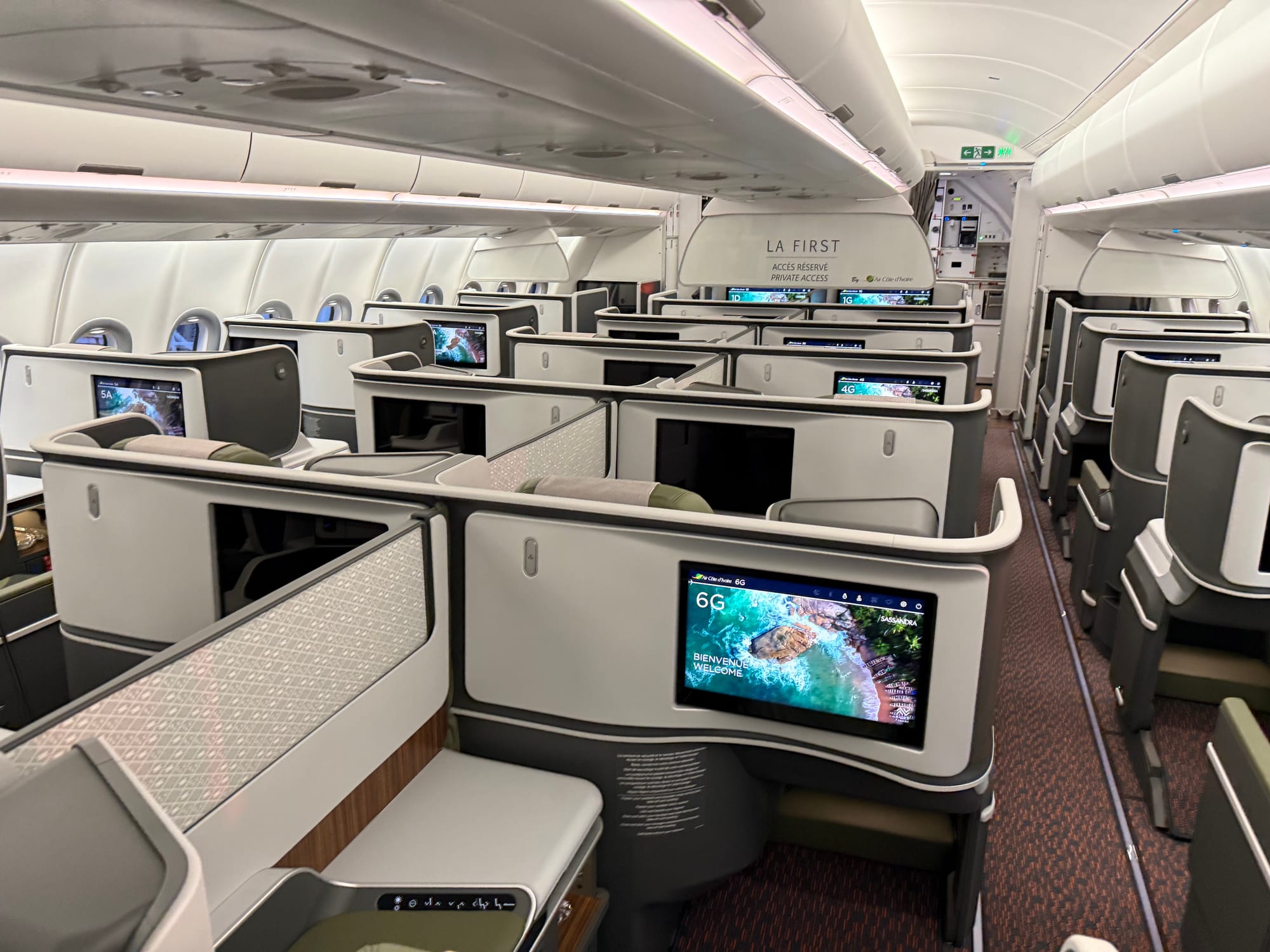
The plan is to start flights to Paris Charles de Gaulle over the next few weeks once certification is achieved, relying on the Ivorian diaspora, a growing domestic middle class, small and medium enterprise corporate passengers, widebody cargo demand, more sociable flight times, and a new hub operation bank at Abidjan to fill the aircraft with connecting travellers from West African countries that Air France cannot serve (for political reasons), does not serve or serves only as a triangle flight in conjunction with another destinations.
Air Côte d’Ivoire director general Laurent Loukou explains (and here we translate from the French used as the working language of the event) that the airline wants “to “democratise” premium travel” for the growing middle class in Côte d’Ivoire and “all the bosses of small and medium businesses” in its forward cabins, and then “when you’ve well managed the business and premium, you can compete at the back”.
The A330neo and its layout feel like a modern high-business-class configuration for a widebody
Working through the cabins from up front to down back, La First comprises the first row of the aircraft, with four seats of Thompson’s Vantage First variant of its Vantage XL studio class doored suite product, which tessellates directly into with the business class seats behind.

This is essentially an updated version of Thompson’s 2018 studio class for Shanghai Airlines, later installed by other airlines including Virgin Atlantic’s 2023 Upper Class Retreat Suite, and works the same as those existing products — except, of course, for being marketed as first class rather than as a business class upgrade.
Air Côte d’Ivoire’s version comes in a series of medium to dark greens, with natural wood accents on the side consoles, deployable tables, and indeed the central console’s connecting table (which Shanghai Airlines rather catchily called its mahjong table).
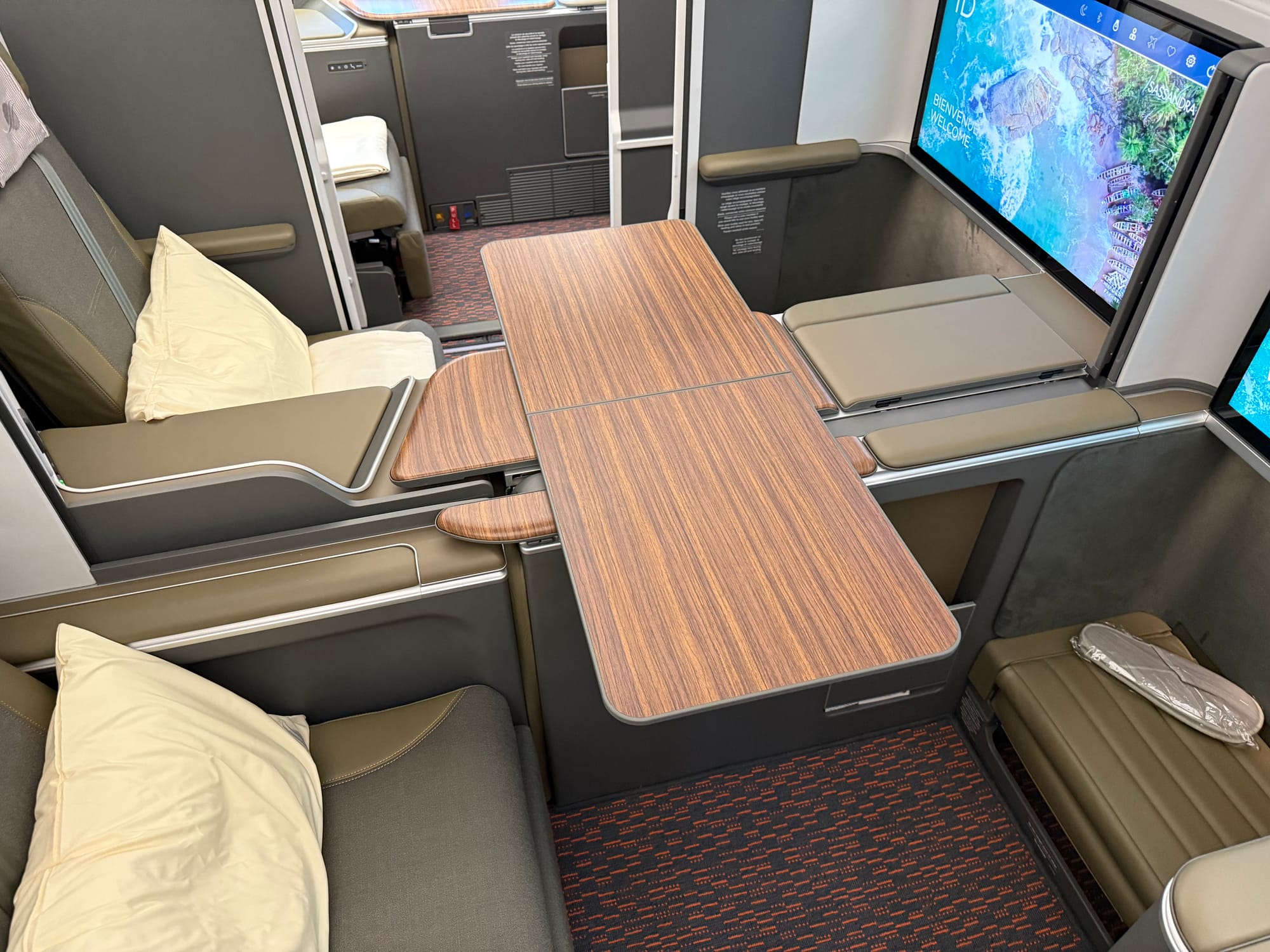
Notably for an airline differentiating its studio class from the regular business seats in the product family, there was no visible change to the colour, material or finish of the seats when we toured the aircraft — not even a La First antimacassar.
It is, of course, possible that the airline plans an upgraded semi-soft product, such as later differentiated seat covers, antimacassars, trim and finish, but it would be unusual for these not to be included at this stage and for the gala event reveal.
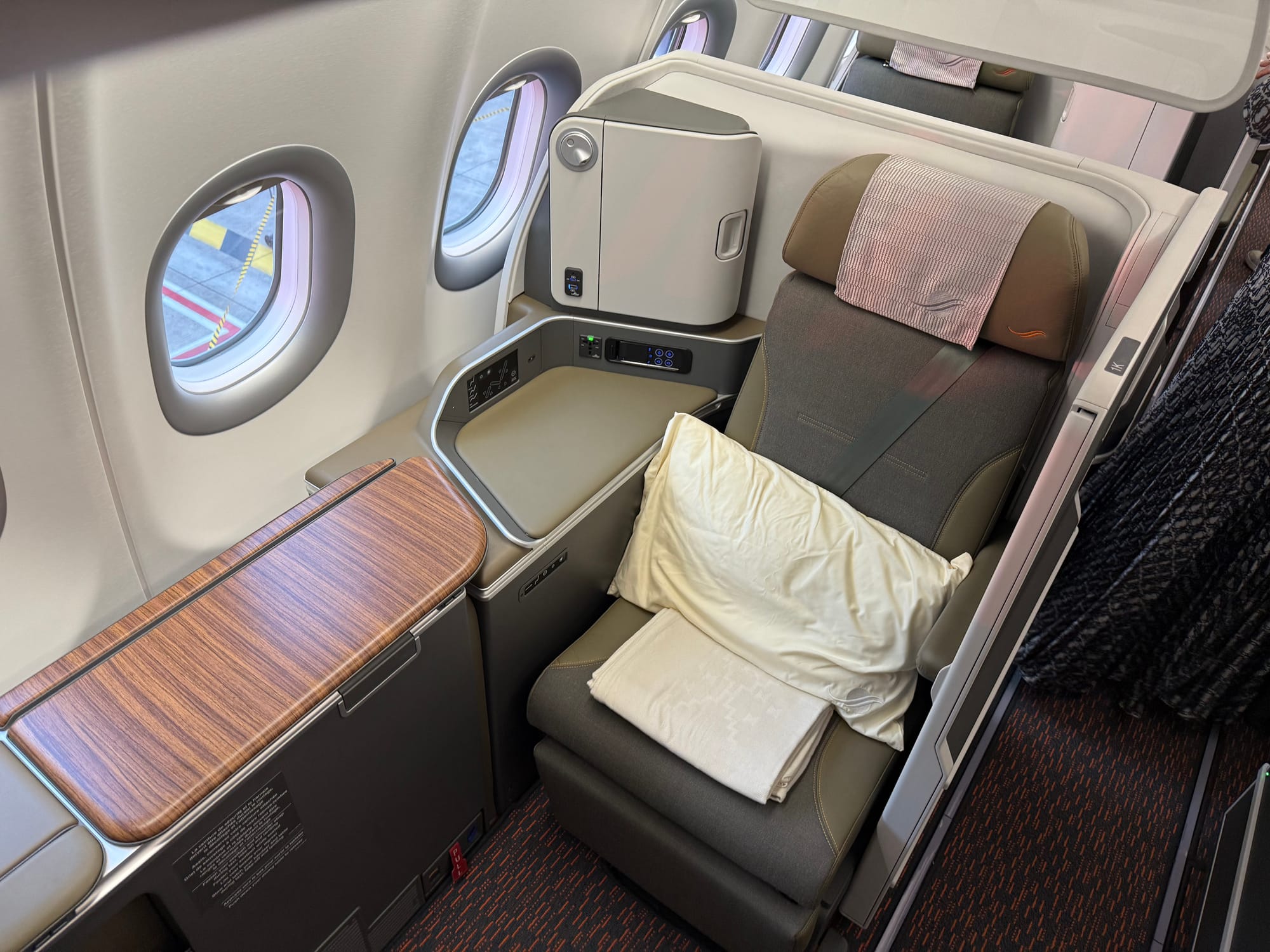
The main differentiator between La First and the business class seats, still the Thompson Vantage XL product, is doors. The 44 business class seats, which span the rest of the front cabin zone ahead of doors 2 and well back into the second zone between doors 2 and 3, do not offer doors.
Behind business sit the 21 Geven Forma premium economy class seats laid out in a 2-3-2 configuration over three rows, whose certification problems we have covered in depth, but which continue the green theme, adding pops of orange accents in the headrests, blankets and pillows.
Given the certification issues, we were only able to sit in the front row briefly, but this felt a very standard modern premium economy product, with the size of screen one would expect.
Subsequent rows are pitched at 41”, somewhere around 1–3” more than Air France depending on aircraft, and better than most of the industry. This product will be a selling point once they can be occupied.
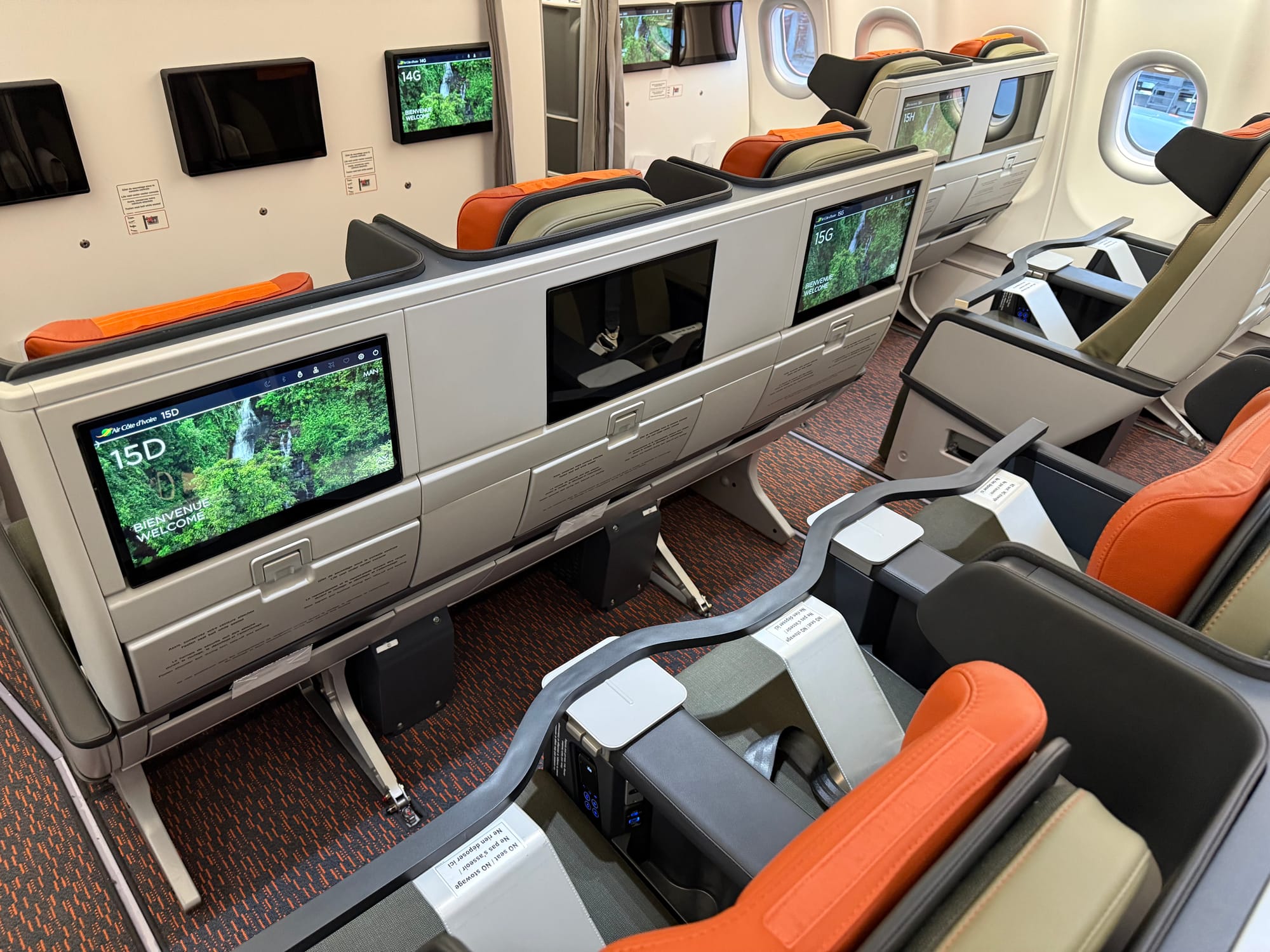
At the rear of the aircraft, ahead of and behind doors 3, are the Geven Elemento economy class seats in a 2-4-2 layout.
This is a notably small economy class cabin at just 173 seats, but in our brief test the legroom seemed generous, with decent shin clearance and a sparkling crisp and sizeable Safran RAVE entertainment screen.
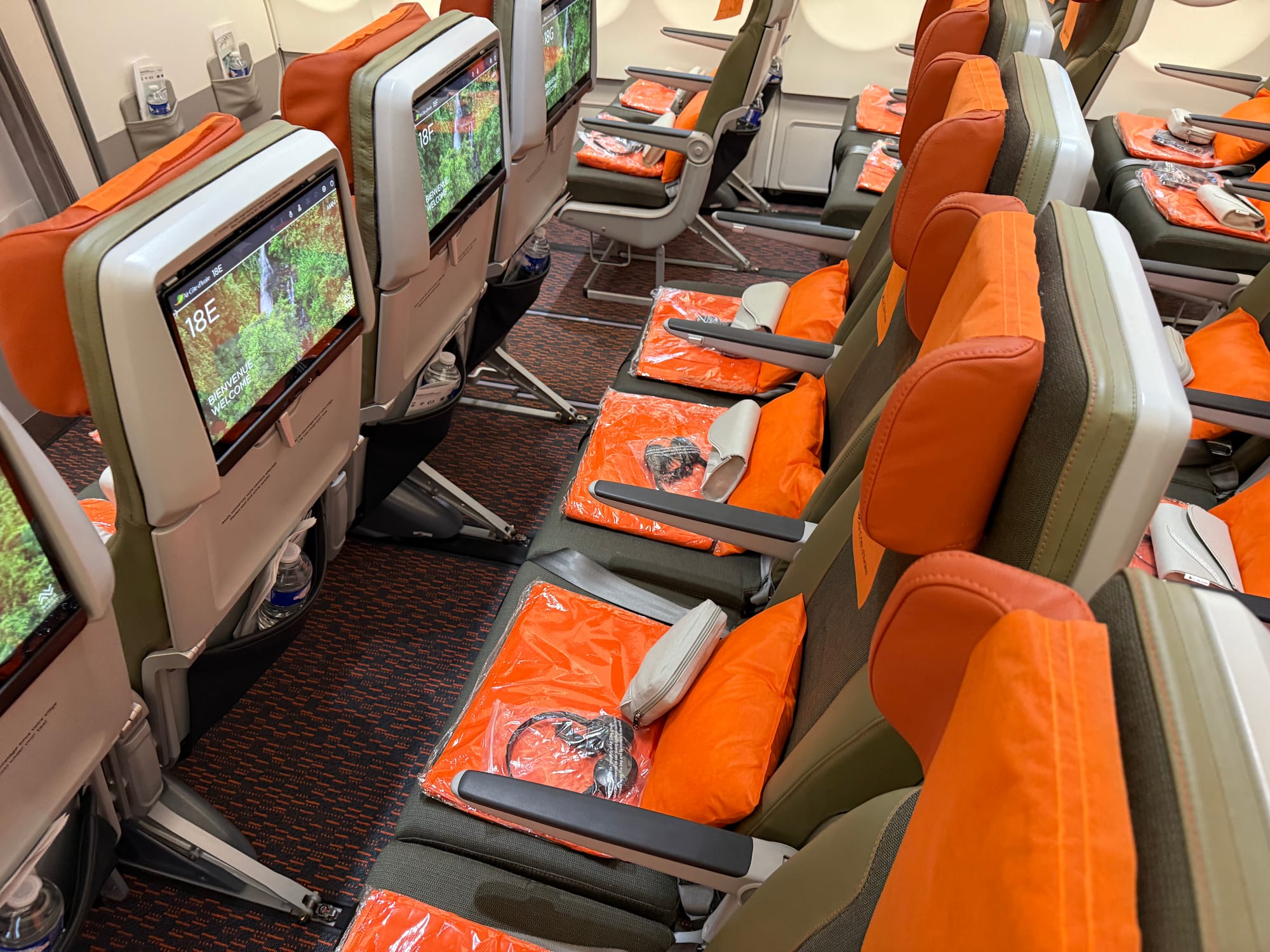
Economy adds more orange to the green mix, but remains consistent throughout the aircraft.
Unusually — and praiseworthily — Air Côte d’Ivoire is one of the few airlines to customise the backlit overhead panels that are part of Airbus’ Airspace cabin generation, using a traditional African woven motif instead of the generic Airbus rhombus.
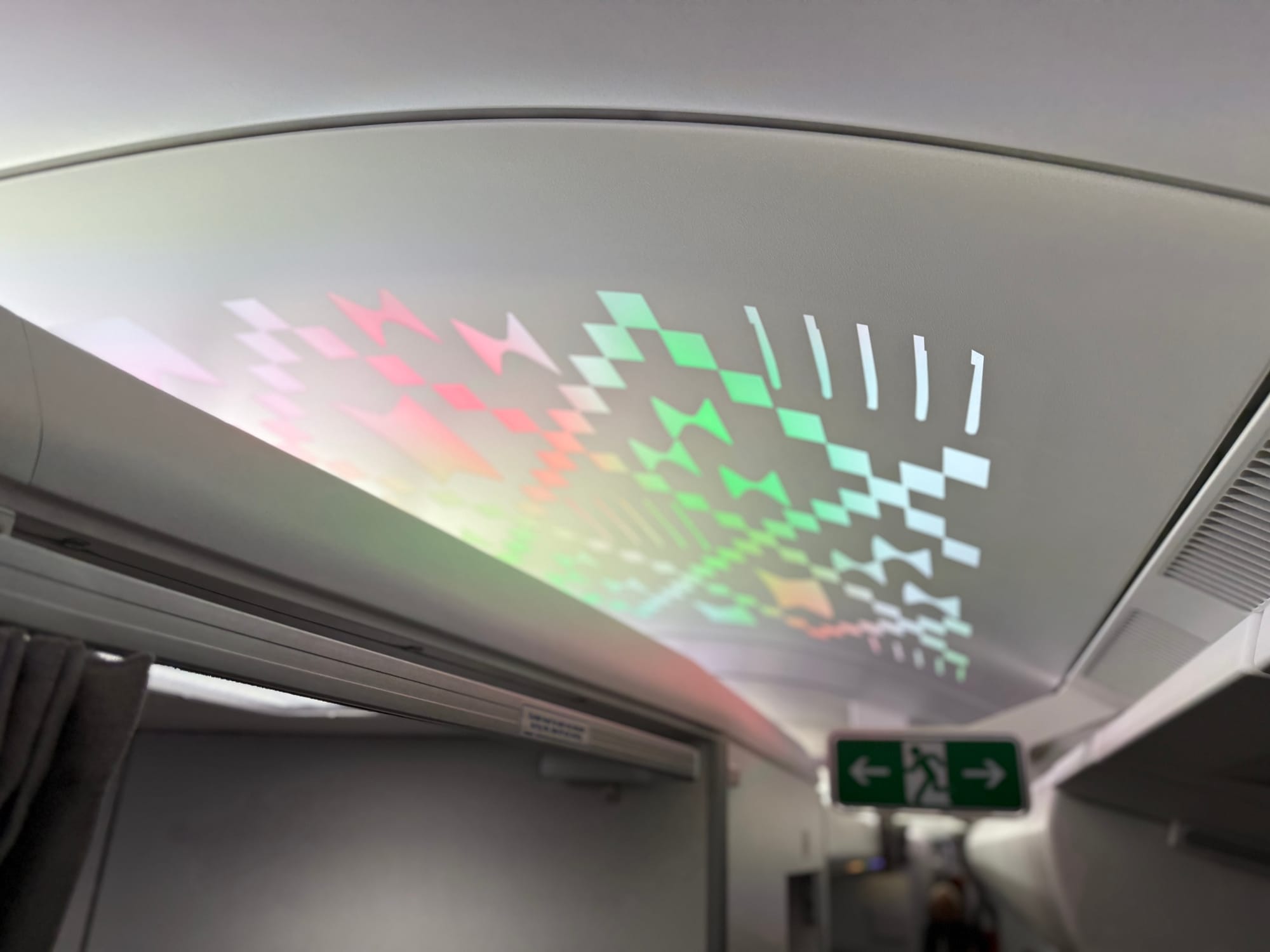
“We are Africans, and we wanted our culture print in this aircraft to make a difference,“ Air Côte d’Ivoire’s Yacouba Fofana tells The Up Front. “This pattern is also present on the business seats and the service material. It comes from African culture, especially the Akan people traditional cloth called kita or kenté.”
Inflight connectivity will be provided by Viasat over satellite, with a three-tier offering: messaging free for all passengers, a one-hour free pass for business class travellers, and a full-flight pass for first class.
Inflight entertainment, meanwhile, uses Safran’s RAVE screens, with content provided via Anuvu, Fofana confirms.
The Air Côte d’Ivoire product measures up well against the competition… or at least what the competition used to be
During a brief press conference after the tour of the aircraft, The Up Front asked airline director general Laurent Loukou — and we translate here from the original French in both question and answer — how he believes the onboard products, stand up to the competition. He responded in reference to the business class products of two competitors’, which he did not name, but which are not hard to deduce.
For the first competitor, which we conclude from its product is French leisure/LCC Corsair, Loukou referred to the the Opal seat from Airbus subsidiary Stelia (which, in fact, Loukou cited as just “Airbus”, not Stelia), and which he called prêt-à-porter, or “off the rack”, compared with Vantage XL, which Loukou referred to as sur mésure, or “bespoke”.
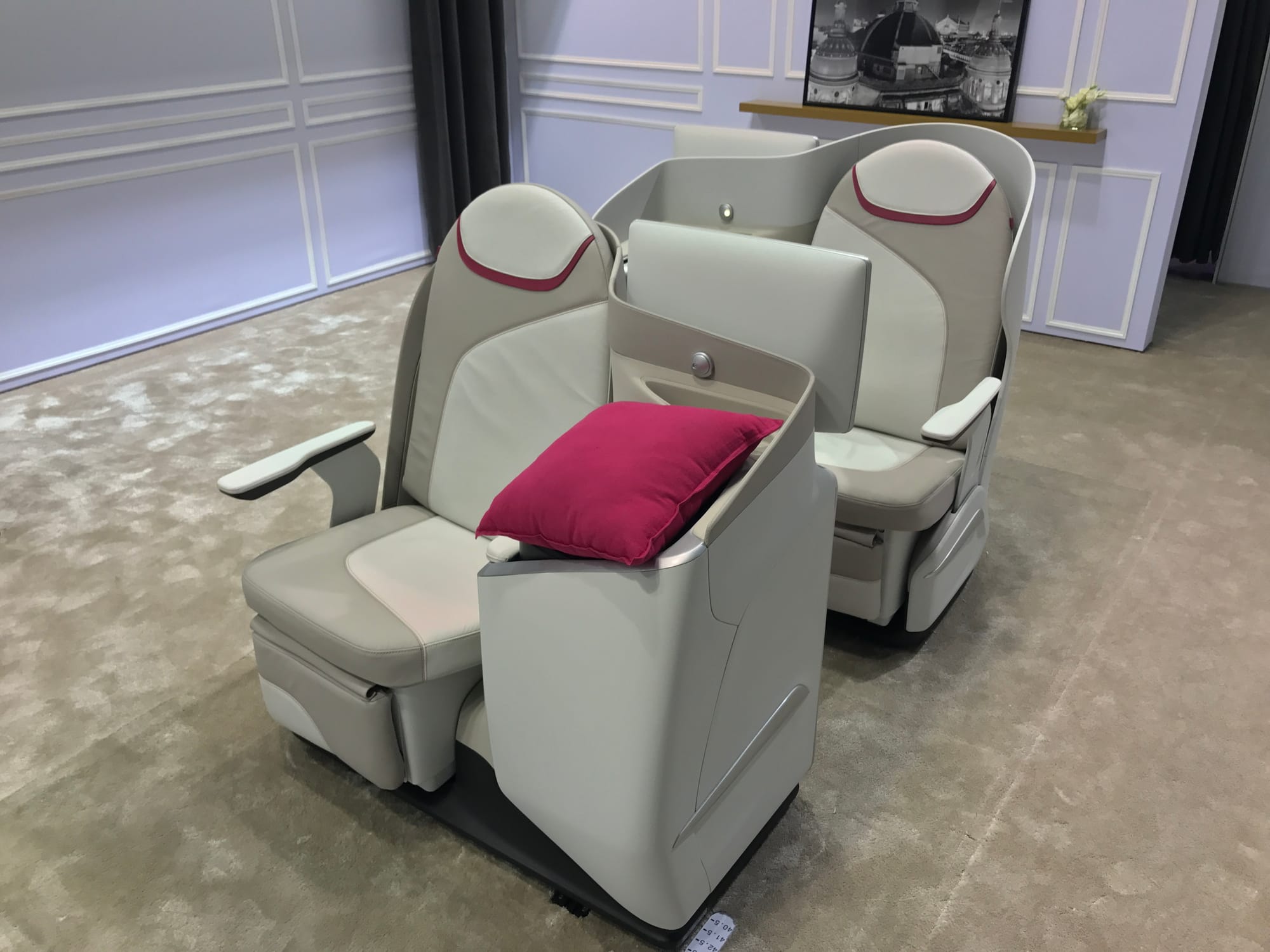
While it’s fair to suggest Opal is off-the-rack, this claim of Air Côte d’Ivoire’s Vantage XL being a bespoke seat is, on balance, a stretch. While, yes, it is possible to argue that it is more customised (and certainly more feature-filled) than Corsair’s Opal, and while Air Côte d’Ivoire has done good CMF work on the A330neo, there is little to differentiate any of the hard products on board from what is seen elsewhere in the industry.
What is impressive about the aircraft is that Air Côte d’Ivoire (and, to their credit, Thompson and Geven) has matched international competitors with much larger budgets and substantial design agency assistance, rather than that it has created a bespoke hard product.
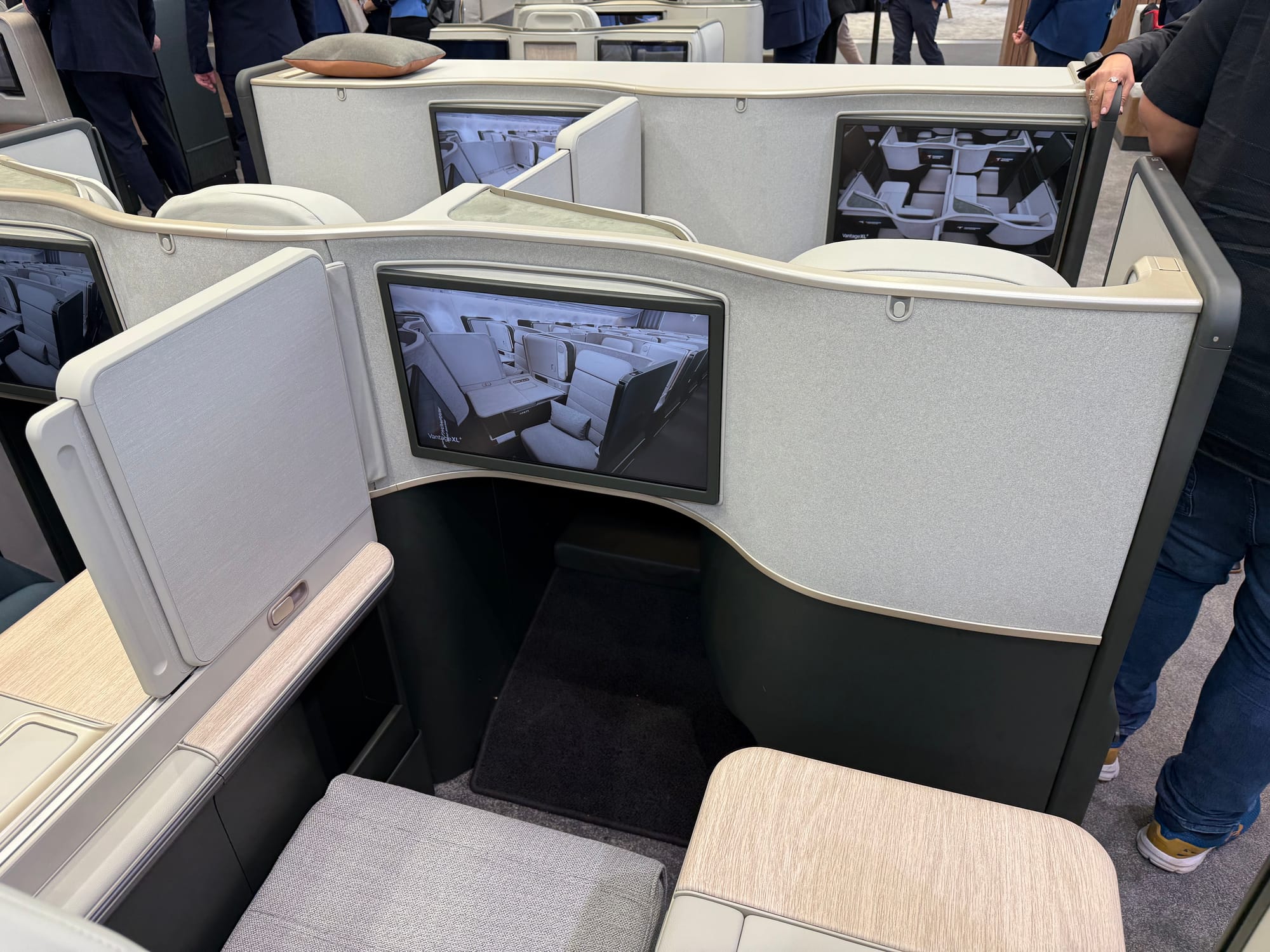
Air Côte d’Ivoire’s second competitor is, by deduction, Air France, and here things get complicated. In his response to our question, Loukou referred to a seat from Collins that he said was of the ancienne génération, “older generation”, and we presume that here he is referring to the Air France seat produced by Collins Aerospace’s predecessor B/E Aerospace.
This is, or rather was a customised angled lie-flat product that Air France refers to as NEV (Nouveaux Espaces Voyages, or New Travel Spaces), and which covered the NEV2, NEV3 and NEV4 generations of very similar product. It is currently being replaced with refurbishments of newer herringbone seats and, to the best of our understanding after reviewing scheduling data, Air France no longer operates any aircraft with the NEV generation of seats.
During The Up Front’s investigation of scheduling and aircraft data for the current period showed a real mix of product onboard Air France’s flights, however. The airline operates almost every longhaul aircraft and product that it offers to Abidjan, including its:
- A330-200 with Stelia Elysium (evolved from Equinox) full-flat beds without direct aisle access in a 2-2-2 layout
- A350-900, original version, with Safran Optima staggered full-flat beds with direct aisle access
- A350-900, second version, with Stelia Opera WB outward-facing herringbone mini-suites
- 777-200ER, with Safran Cirrus outward-facing herringbones
- 777-300ER aircraft with outward-facing herringbones of multiple types
- 777-300ER, “COI” (Caribbean-Indian Ocean) low-J version with Safran Optima
Comparing these hard products with Air Côte d’Ivoire’s Vantage XL, the A330-200’s Elysium is markedly below, while the Optima products and non-doored herringbones are roughly similar in quality level. The doored suite herringbones are superior.
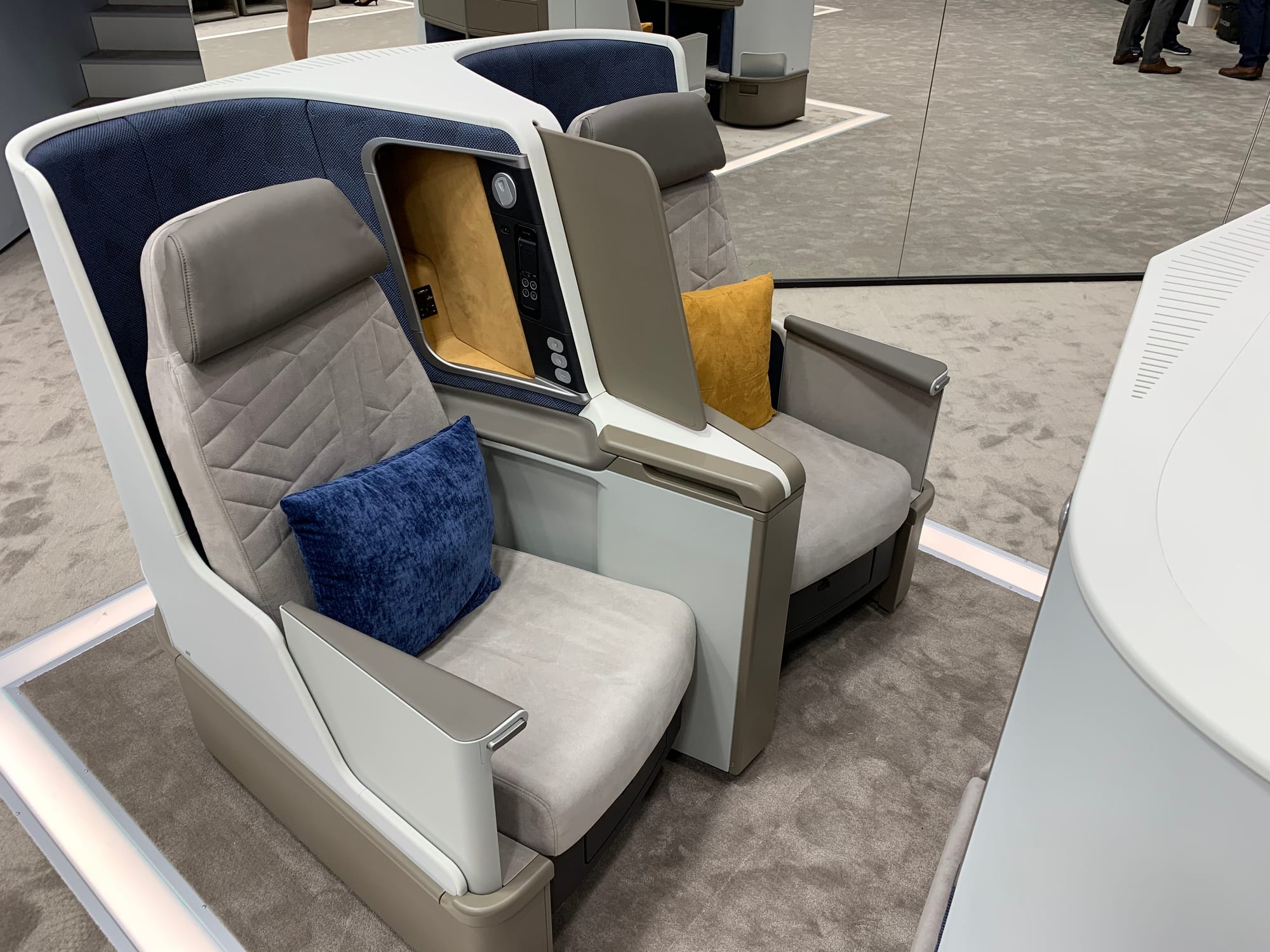
Where does that leave business class passengers? Well, the big question would seem to be one of consistency. Book Air Côte d’Ivoire and you’re guaranteed a seat with direct aisle access. Book Air France and you may not be guaranteed that direct aisle access, depending on the flight.
As for first class? Air France doesn’t offer it on every flight, so again consistency is an issue. However, where Air France’s La Première is offered, it’s hard to argue that Vantage First studio class seats are in the same league.
The crux for Air Côte d’Ivoire is that Air France is able to respond flexibly to this new threat to a market that it has dominated. It can flex in capacity with larger aircraft, it can flex in experience with its better cabins, or indeed can do a mixture of both.
La First’s success will depend on pricing and pitching: it’s a solid studio class, but it’s no La Première
Many eyebrows were raised when Air Côte d’Ivoire first announced it would offer a first class cabin — this is certainly not the norm for small national airlines, which generally top out at business class.
The availability of the “first class for free” (as Thompson puts it) innovations around studio class is clearly a benefit, so The Up Front asked Air Côte d’Ivoire head of marketing Yacouba Fofana outright why the airline decided on a first class, and the extent to which the availability of studio class was a factor as the airline tries to market those seats.
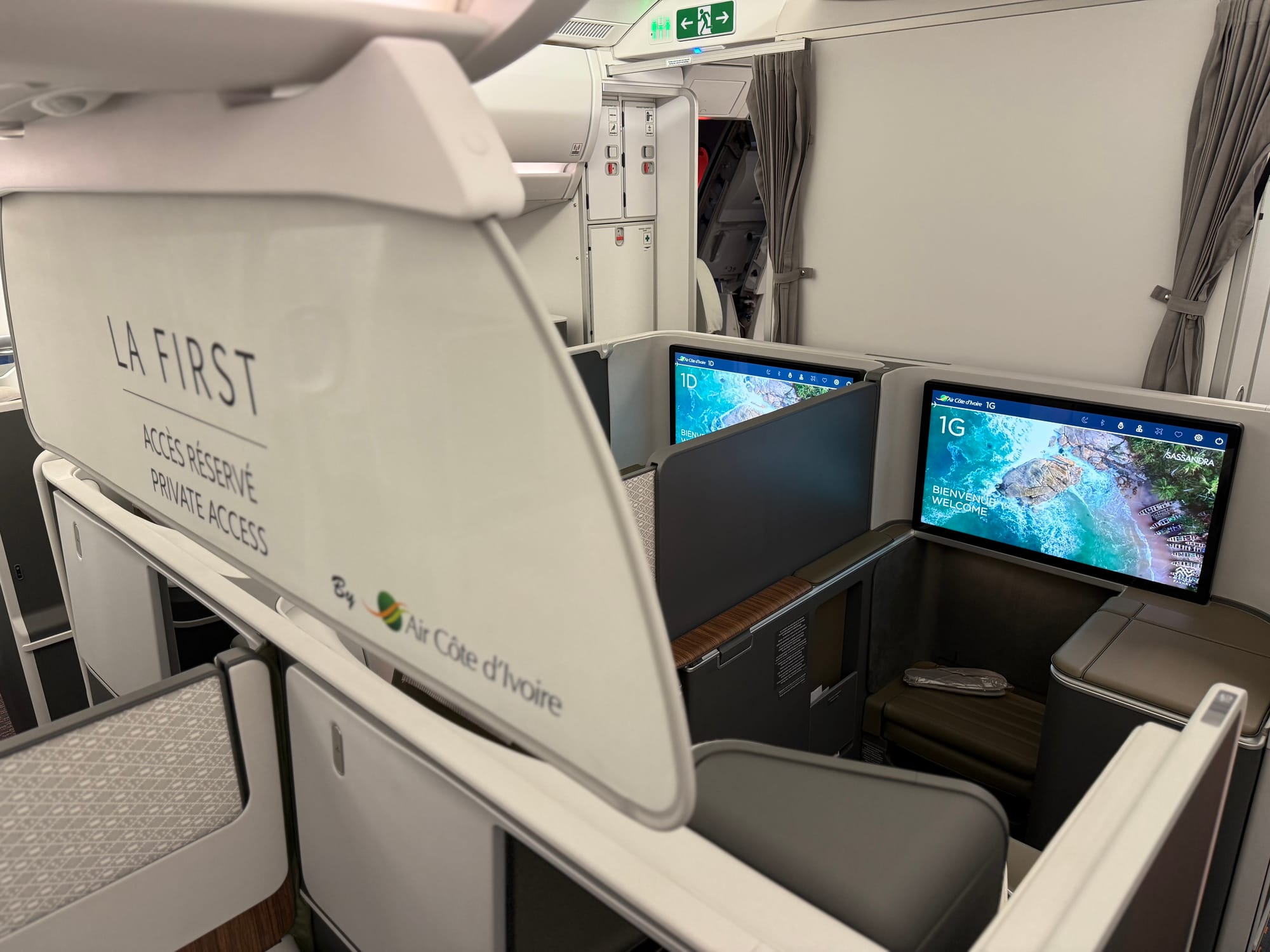
“We have a demand for first class in our market. This is the only one reason” for offering first class, Fofana told us, but also noted that, “just after COVID and the market recovery, suppliers were under-capacity for production and we had many constraints to consider when producing this aircraft.”
In context, Air France’s operation of some of its flights on this route with a La Première-equipped 777-300ER suggest that Air Côte d’Ivoire is not the only one spying a lucrative luxury passenger base.
That passenger base, however, still wants to get value for money, and Air Côte d’Ivoire plans soft product upgrades to differentiate La First from business class: “in terms of comfort kits, first class will always have a little more than business class. For example, first class will have pajamas [and] a mattress, while business class will have a mattress topper,” Fofana promises.
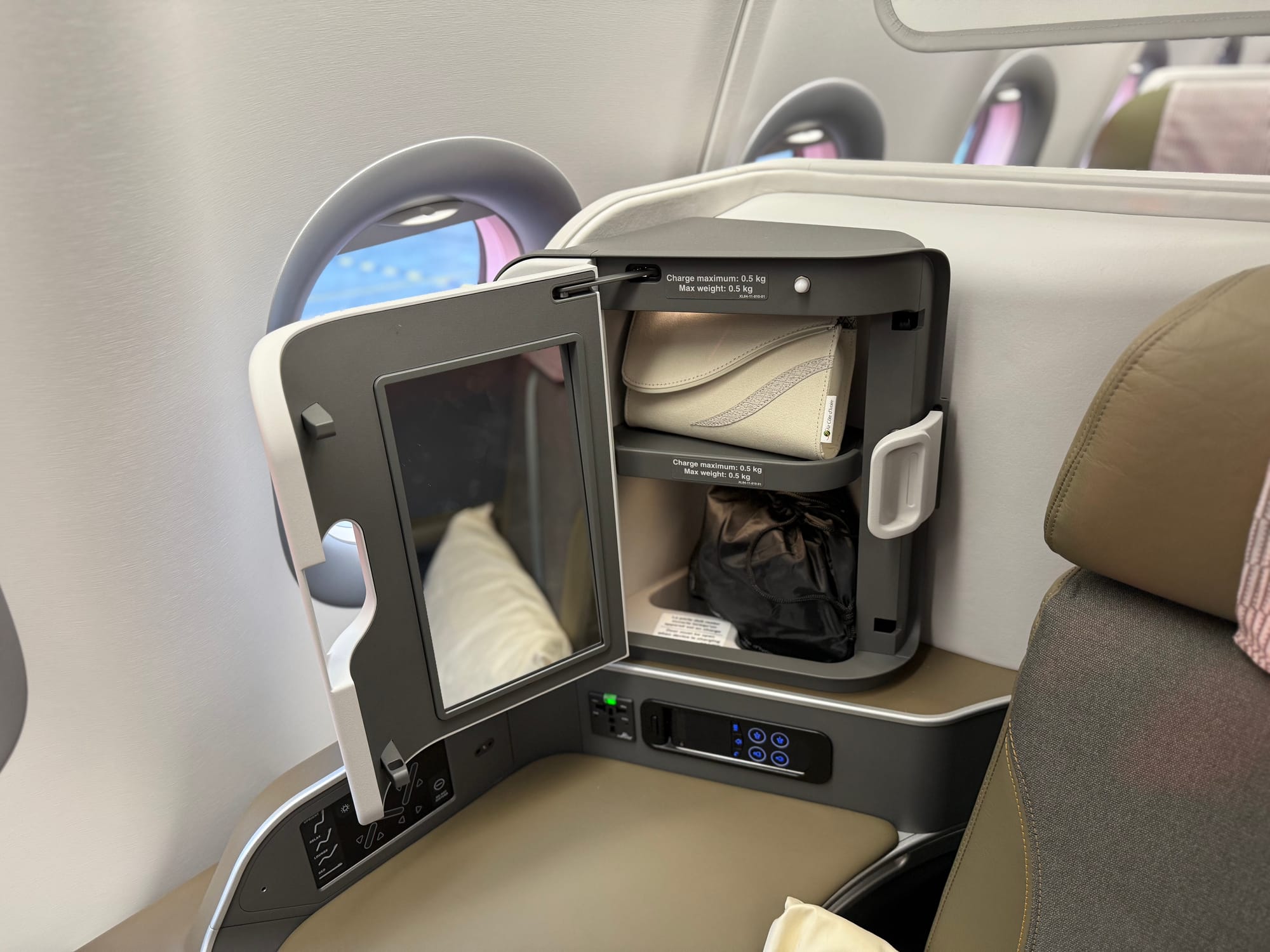
Onboard, there is less physical distinction between first and business on Air Côte d’Ivoire than on Air France or, indeed, most other first class products.
La First is separated from business class only by overhead fixed hanging panels above the seats, of the sort that one might find on European airlines separating Eurobusiness from economy instead of a curtain hanging from the overhead bins. There was, when we toured the aircraft, no barrier curtain, rope, or similar.
When the cabins were first teased and then revealed via online video, we wondered whether the relative absence of a cabin separator — airlines have used everything from floor-to-ceiling curtains to red velvet ropes and placards to separate their classes of service — meant that La First was perhaps a sign of an emerging or unusual first class market where passengers might want to be seen to be seen, to Instagram their way through the skies, to be visible but separate in the VIP section.
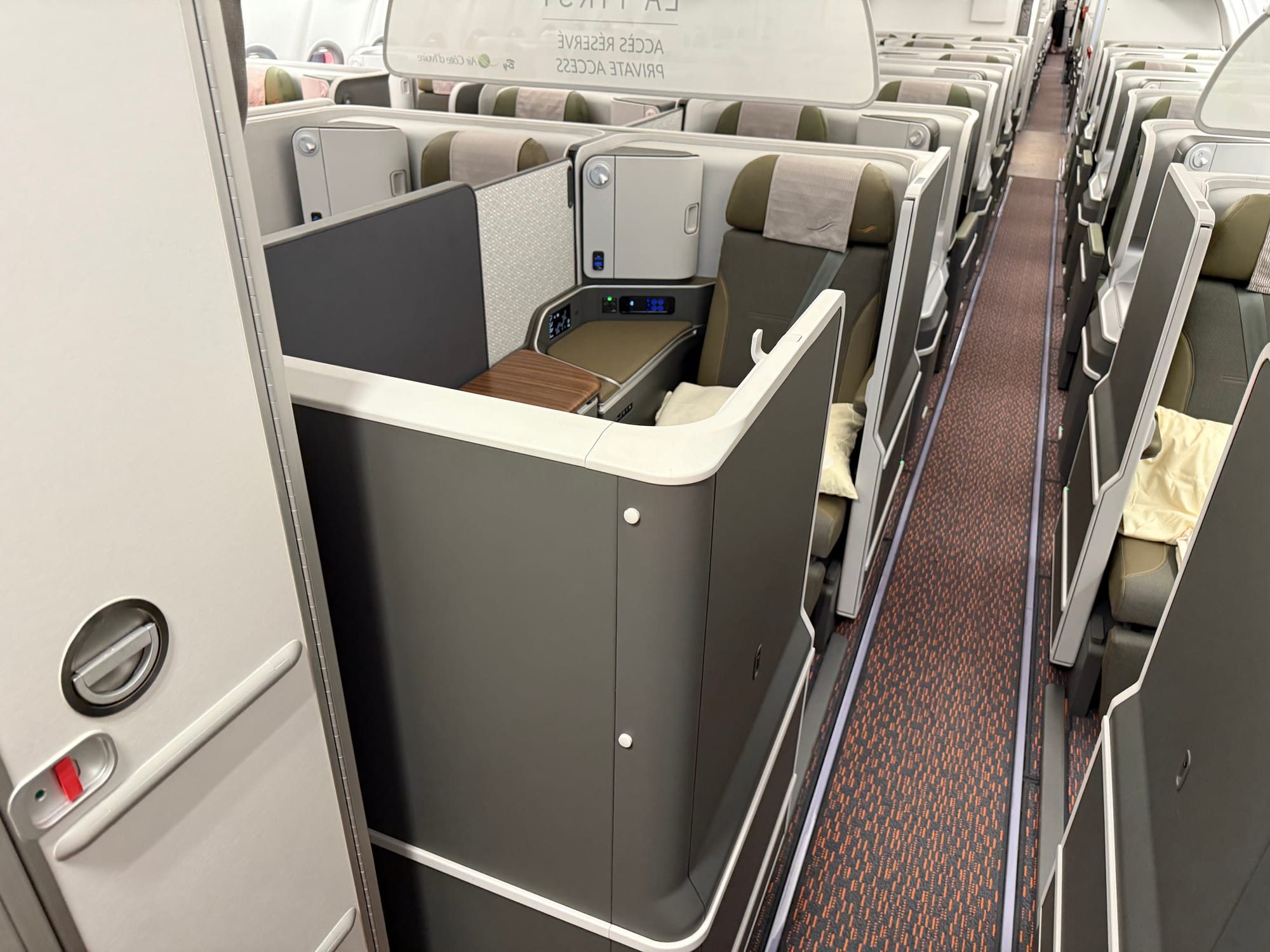
The reality, however, is more prosaic, Fofana reveals: “regarding the constraints just after COVID, this type of divider was the only option we had to separate both classes.” It will be instructive to observe whether this is enough for first class passengers to feel they are in a first class part of the aircraft.
First class passengers will also see an upgraded ground service: “departing from Abidjan, the passenger will have access to the business terminal of Jetex and we are negotiating a VVIP terminal for departing from Paris for a very premium experience,” Fofana confirms.
It will be fascinating to see how the passenger experience works using the Jetex terminal in Abidjan — a private aviation Fixed Base Operator (FBO) terminal to the south side of the airport well away from the main terminal — and whichever Paris private terminal the airline decides on will work for Air Côte d’Ivoire, which The Up Front understands is planning to use terminal 2C at Charles de Gaulle.
Thinking about the wider experience and especially first impressions, the question of how first class passengers will board the aircraft will be an important one to answer well. Some private terminal operations can board passengers from the foot of the aircraft to the jetway, some have to board into the terminal.
And onboard, it was notable that at door L1, there was no special first class welcome area, just a white galley wall. Will the airline board through this door rather than L2, and if so is something more on the way?
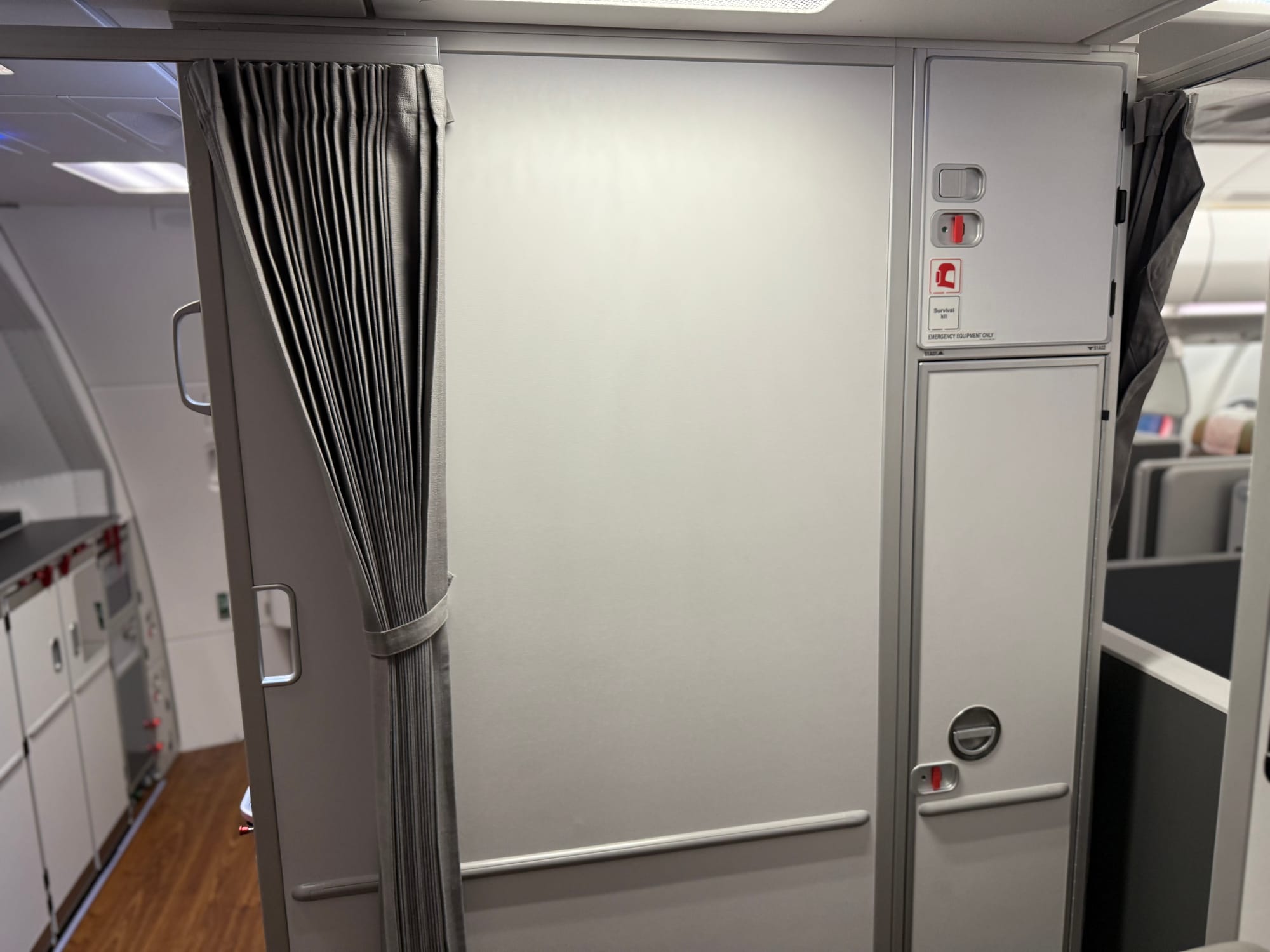
Business class is a very competitive Thompson Vantage XL, but without doors… is that enough futureproofing?
In the main business class area, Air Côte d’Ivoire’s 44 Vantage XL seats, without doors, are arranged in their usual staggered layout, starting immediately behind La First, with the footwells of the front row of business comprising the side tables of first class.
The colours, materials and finish vary in levels of customisation and innovativeness: the seat covers are a series of greens in fabric with leather trim, while the surrounding shrouding is mainly light and dark grey.
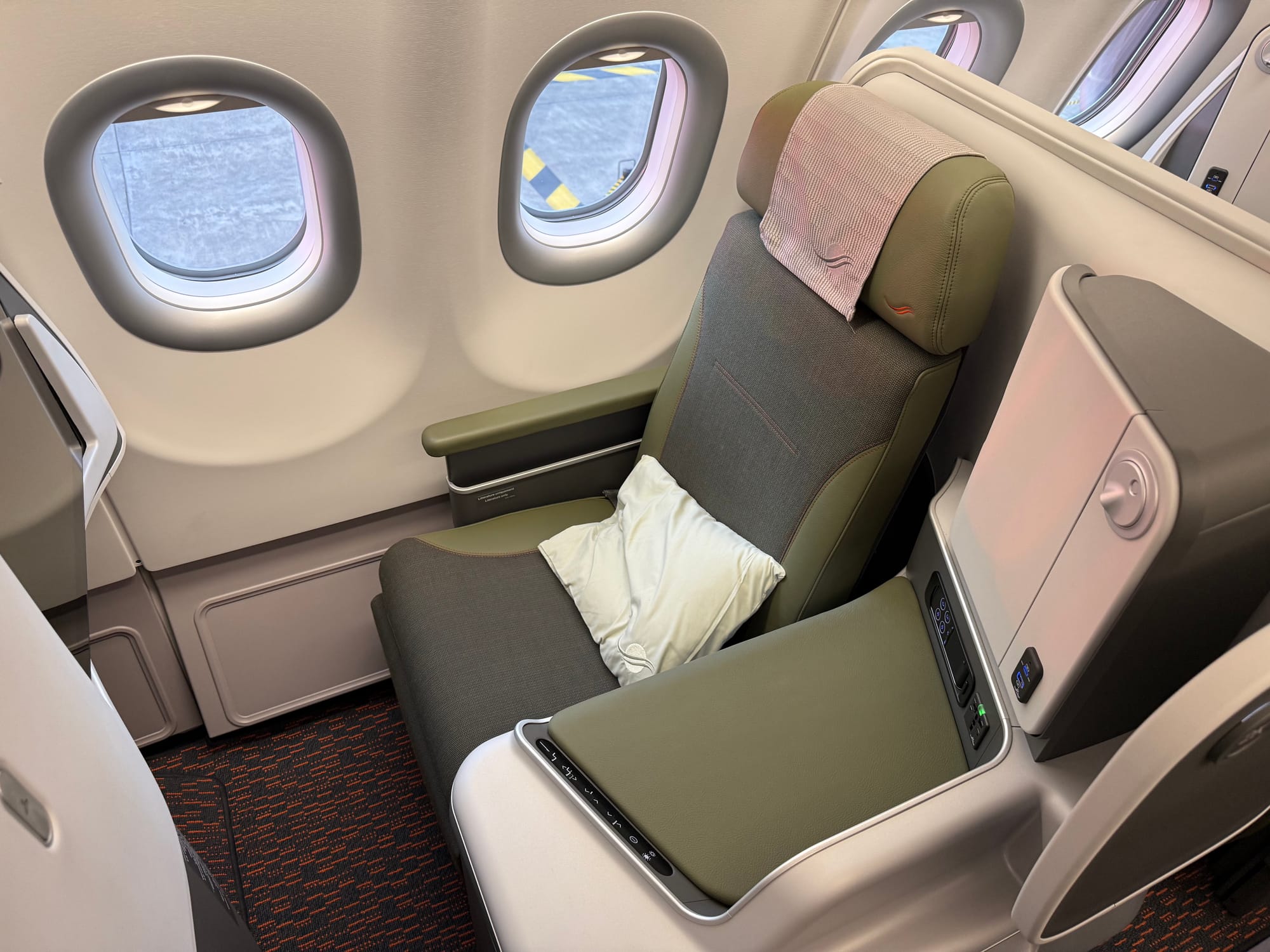
The centre dividers feature a traditional woven cloth motif, while the side tables are the newer Thompson model with the diagonal split controls and more of the green leather.

A few feature elements include an attractive grained wood effect material as well, while the carpet (throughout the aircraft) is a cheery orange and black series of stripes that works well with the green — and is, of course, reminiscent of the orange-white-green tricolor flag of Côte d’Ivoire from which the airline’s colours and logo are drawn.
There are no doors in the main business class, which Air Côte d’Ivoire’s Fofana tells us is because “we needed to make a difference between first and business. This was the best way to do it.”
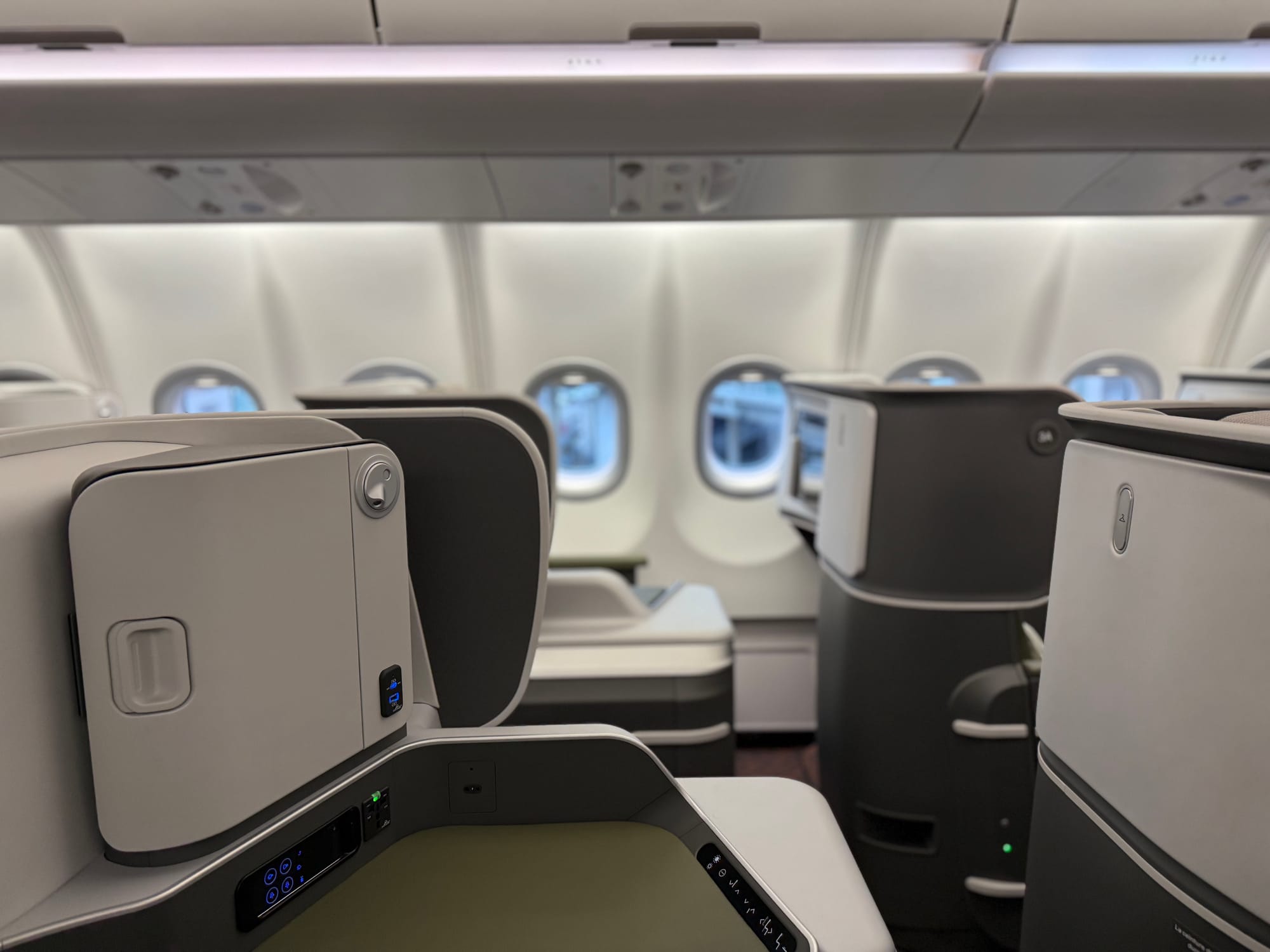
The choice of Thompson, meanwhile, came after “we saw lot of business seats I will not mention here but all the suppliers were under capacity of production [constraints]. Thompson was our first choice because of their good reputation and also the characteristics of their seats regarding the full flat position, which is straight.”
In the competitive context, Air France is coalescing towards herringbones but also offers some staggered product with Optima, and slightly angled forward-facing seats without direct aisle access with Elysium, while Corsair offers a forward-facing stagger with Opal.
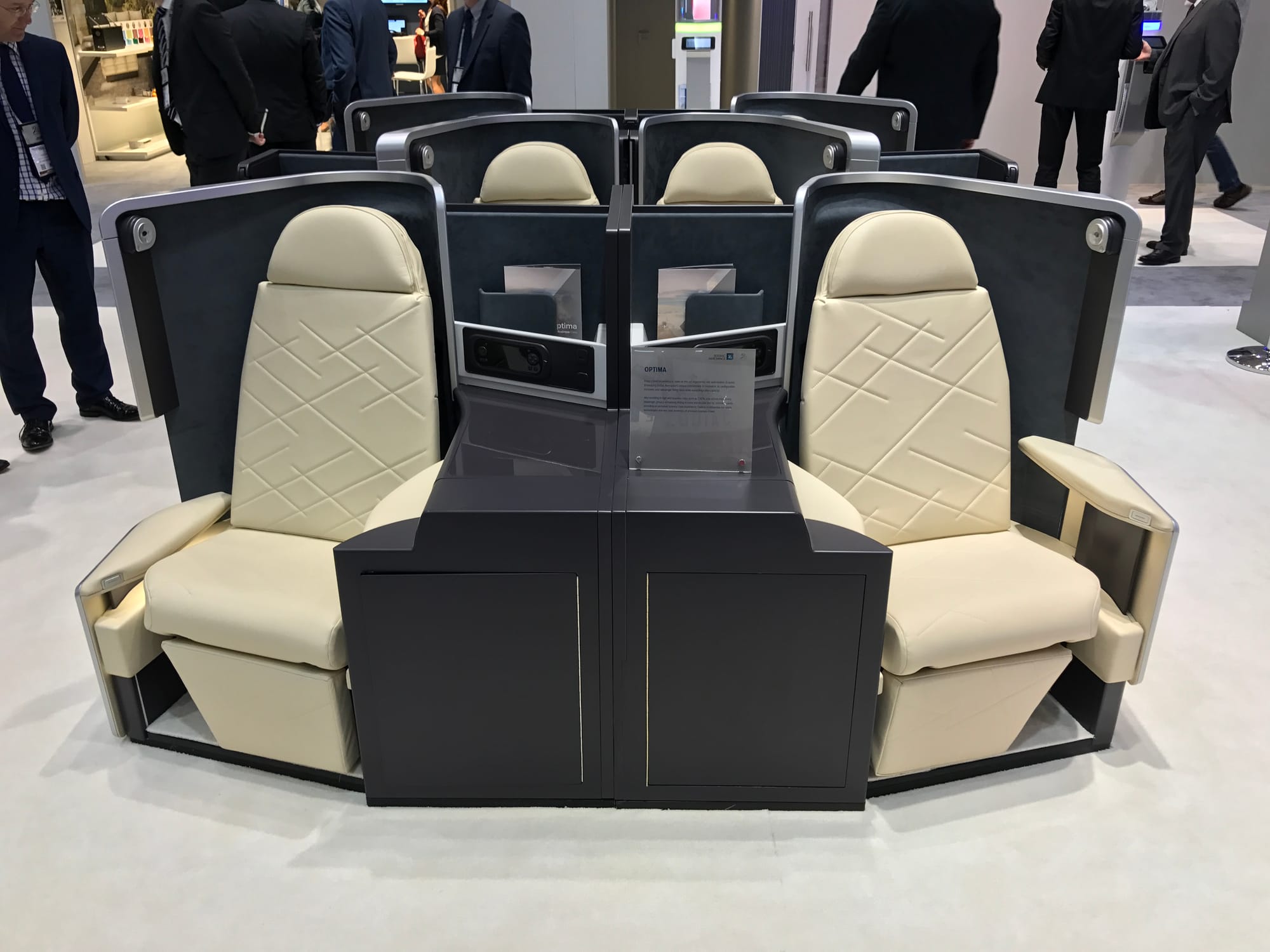
It’s clear that Air Côte d’Ivoire wants to compete on pricing, too.
“We want to democratise comfortable travel and provide everyone the opportunity to travel under good conditions,” Fofana explains. “Our business class will be more accessible in terms of price than that of the competition for an equivalent or superior service. We believe that this approach will allow us to fill our business class.”
Of note, the seats behind doors 2 are regular business class seats, whose footwells tesselate forwards into the monuments, rather than being larger business class suites à la La First or Virgin’s plans for its high-J A330neo configuration Retreat Suites.
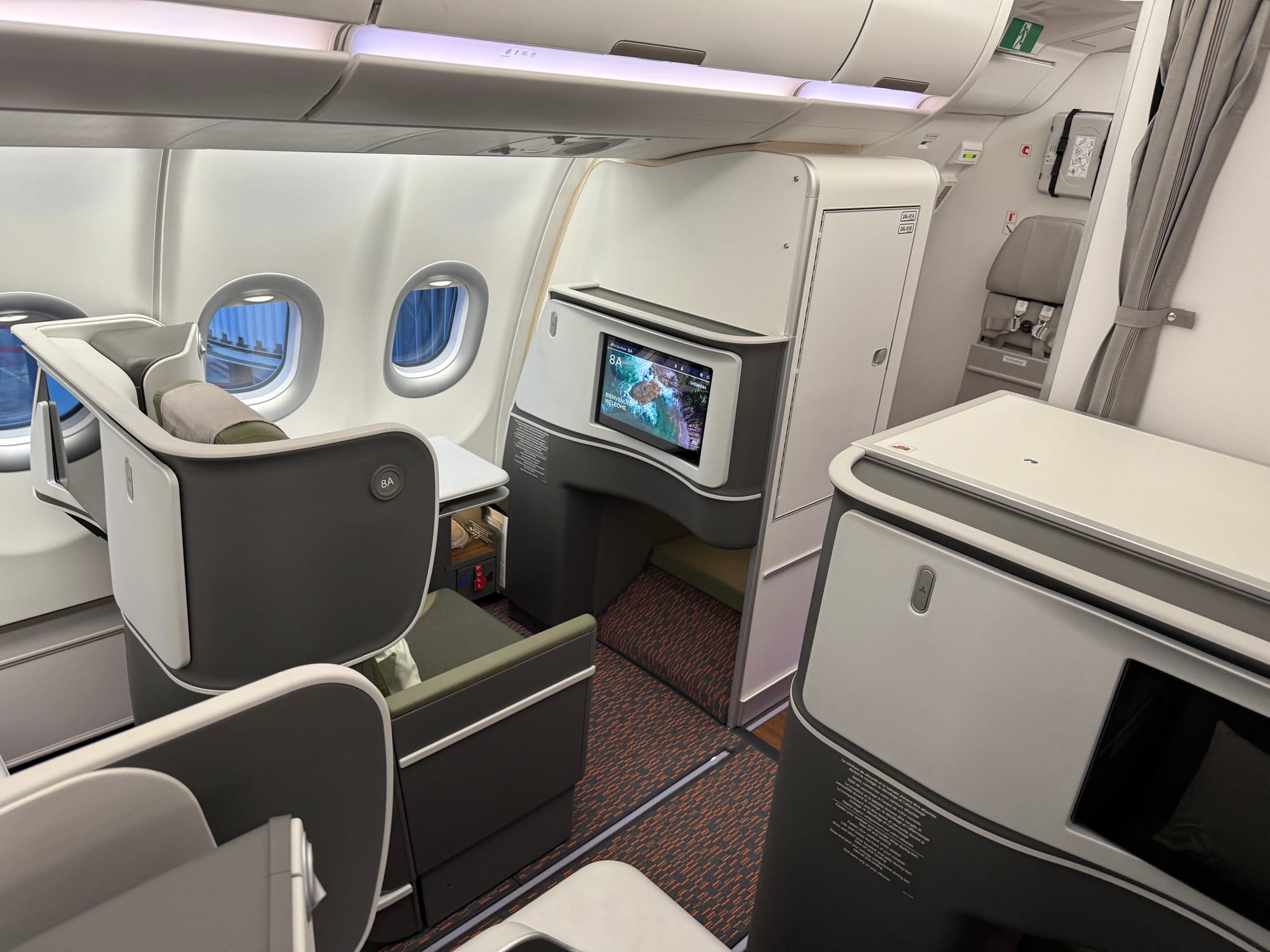
The aircraft is impressive overall, even with the caveat of the blocked-off rows of premium economy
Overall, this is an excellent set of cabins, laid out in a configuration that one can imagine might well resemble a green-and-orange version of the red-and-brown future high-J Virgin Atlantic A330neo fleet.
Business class (and first class) production quality is high, with none of the visible flaws in manufacturing, production and assembly that have come to characterise many other product releases in recent years: no mismatched joins, no slipping fabric elements, nothing unattached that should have been attached.
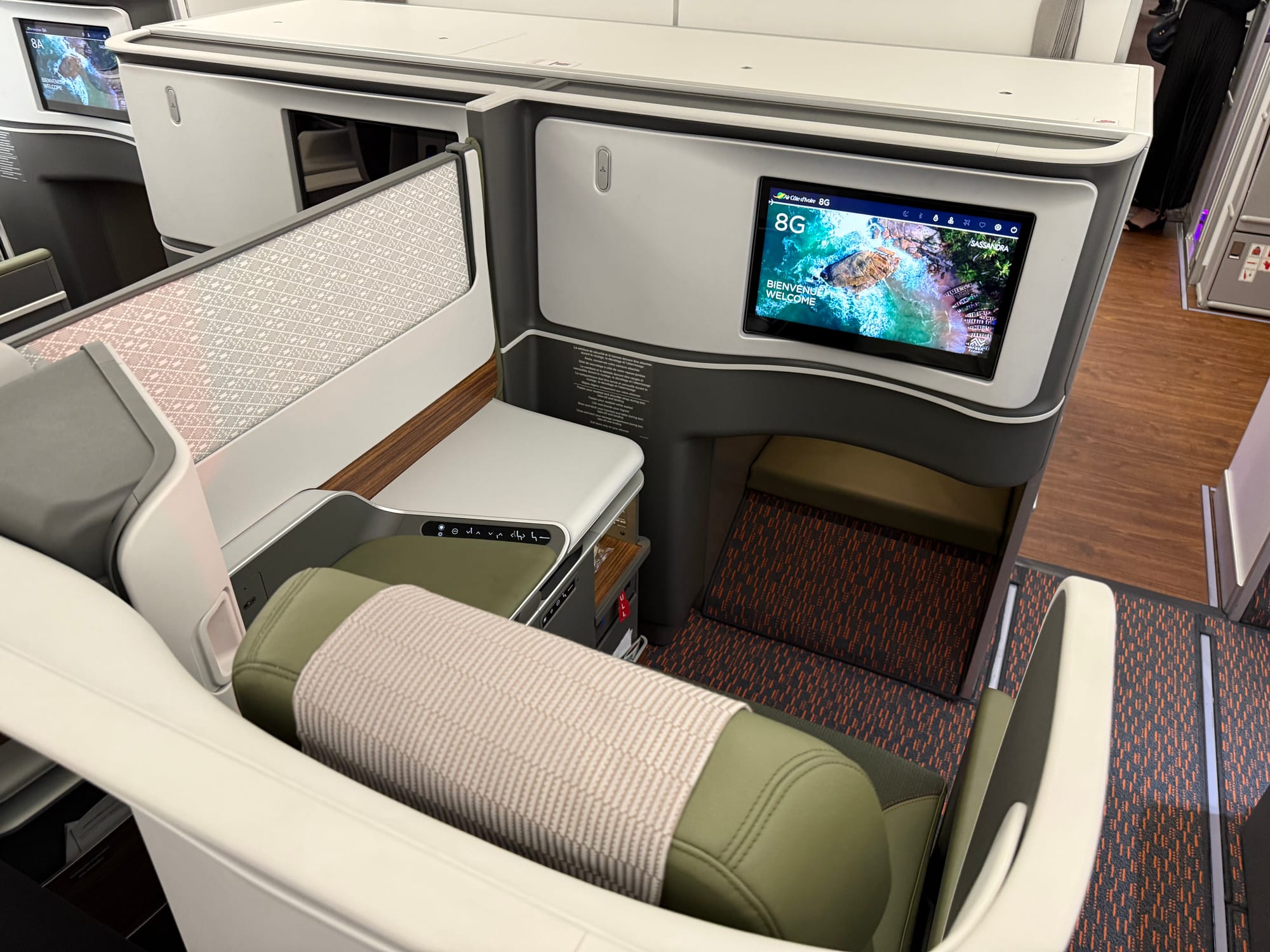
Yes, two thirds of the premium economy cabin is as yet uncertified, but the seats themselves seem to be well manufactured, and 41” of pitch is above average.
The economy product looks to be good too, with a decent amount of legroom, above-average headrest, and the bright pops of orange.
Obviously, though, this is a very high-J aircraft, suggesting that Air Côte d’Ivoire sees a major opportunity in the business class space, and is keen to undercut Air France on price. And there’s the rub.
Operations, economic questions and the wider context of the Abidjan hub will make or break this aircraft’s success, and perhaps the airline’s
The Air Côte d’Ivoire A330neo fleet will be concentrating on flying Abidjan-Paris, then expanding to Abidjan-Beirut to serve the substantial market between the two countries.
At launch, the airline is concentrating on the Paris route, with daily afternoon flights departing Abidjan around 1400 and arriving into Paris around 2000, with the returning flight departing Charles de Gaulle in the morning and arriving into Abidjan at around noon. That does, of course, mean quite the substantial (and pricey) overnight sit at CDG for the aircraft.
Corsair and Air France largely depart Paris Orly and CDG respectively in the afternoon, arriving in Abidjan in the evening, then returning as a redeye from Abidjan and arriving in Paris the next morning.
While the Air Côte d’Ivoire schedule will require an expensive overnight sit at CDG, airline director general Laurent Loukou highlighted that the planned schedule is beneficial in multiple ways, noting in order:
- an evening arrival avoids Paris’ notorious traffic jams
- avoiding the early morning arrival means no waiting around for a hotel room or having to pay the previous night’s rate to be able to shower, change and prepare for meetings
- the opportunity to create a regional hub in Abidjan to serve many of the 20-some destinations Air Côte d’Ivoire already serves via timed banks to feed and meet the A330neo flights
Here we come to the wider picture: Corsair will be competing on price, while Air France will be competing on product and price, so the context of Air France’s product and pricing strategy to routes like Paris-Abidjan is important.
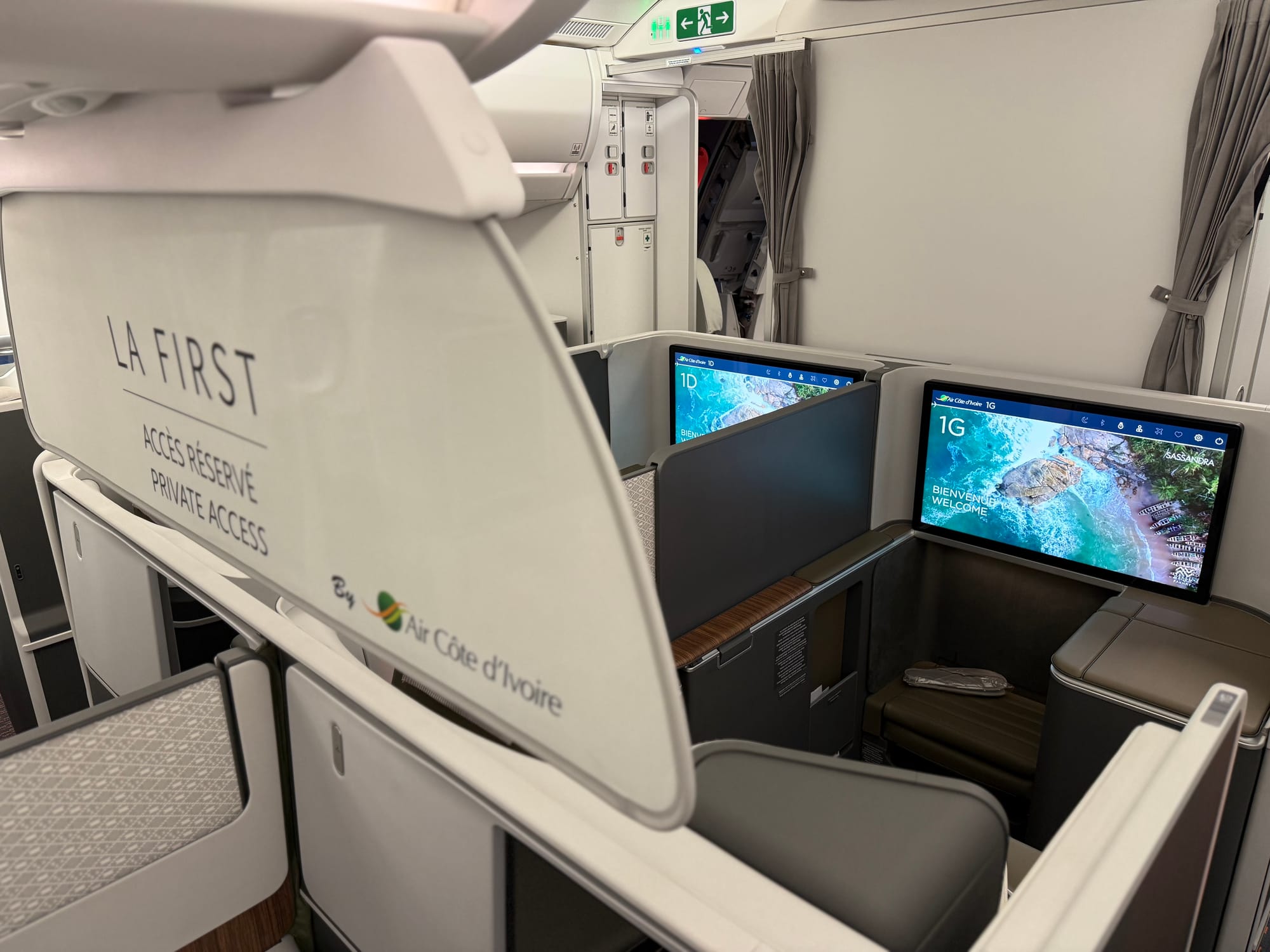
There is a sense among many in former French colonies like Côte d’Ivoire, shared by France’s overseas collectivities, departments and regions — places like Saint Martin, New Caledonia, French Guiana, Réunion, and so on, that are still officially part of the French Republic — that Air France has, not to put too fine a point on it, left its sub-standard and/or elderly seats and aircraft on these routes while higher profile routes like New York, Singapore or Tokyo get a much better experience without commensurate ticket price differences.
While there may well be financial reasons for this product choice, including business class density compared with yield, the sense of unfairness or being taken advantage of was certainly expressed by several of the Ivorian journalists and other non-airline attendees who talked to us about how they see the Paris-Abidjan market at present before Air Côte d’Ivoire enters it. As one put it: sub-standard product and cheap fares on Corsair, or sub-standard product, expensive fares but a good connection on Air France.
Air Côte d’Ivoire is, of course, a state-owned airline, and one with the very closest ties to the state: the First Lady was the guest of honour at the gala dinner in Toulouse, while two government ministers (of Transport and of Culture-Francophonie) plus multiple ambassadors were also present.

It was clear from the speeches and later discussions that the government sees having a widebody fleet — whose operations, international nonstop connecting routes, and substantial cargo capacity it can, to whatever extent, direct or influence — as beneficial to the country.
Capacity guarantees are one benefit, but another is the ability to set entry pricing, and that’s even more effective with an aircraft where much of the product is at or above the competition business, premium and economy.
Air Côte d’Ivoire director general Laurent Loukou was at pains to emphasise to local media, who were understandably keen to hear details of the route’s pricing, the difference between lead-in fares and modal pricing, before revealing lead-in fares between Abidjan and Paris of (in West African CFA XOF francs, the shared currency of eight regional states that is pegged to the Euro):
- 1.3 to 1.4 million CFA (approximately €2000) in business
- 700,000 CFA (approximately €1100) in premium
- 300,000 CFA (approximately €450) in economy
Notably, Loukou would not be drawn on pricing in La First.
The proverbial ball of Air Côte d’Ivoire’s value proposition is, therefore, rather in Air France’s court. The French airline’s response to the presence of the Air Côte d’Ivoire A330neo may well be to roster its better product on its Abidjan flights, to cut fares — or both, which would be a standard linked move in the airline handbook.
It may well be that Air Côte d’Ivoire has the ability to undercut Air France on price if it can establish a lower cost base in Abidjan. It may be that its schedule proves more attractive to passengers, and that its new West African hub strategy at Abidjan works well to feed its widebodies. It may be that its management has overestimated its market power. It may even be all those at once. But it is an impressive and courageous effort in any case.
The airline plans to start flying daily to Paris “within three to four weeks” of delivery, so late September or early October 2025, with Beirut following, and flights to the US from 2028/2029 if all goes well.
The Up Front is continuing to delve into the ongoing certification issues in the aircraft’s premium economy — and elsewhere in the industry — and will bring those to Pro readers as our reporting develops.
This article is free to read thanks to reader subscriptions to The Up Front, whose support enables us to release around half of our articles in public. If you’re a subscriber, thank you. If you’d like to become one, support independent aviation journalism and unlock all our work, visit theupfront.media/subscribe for more information.

